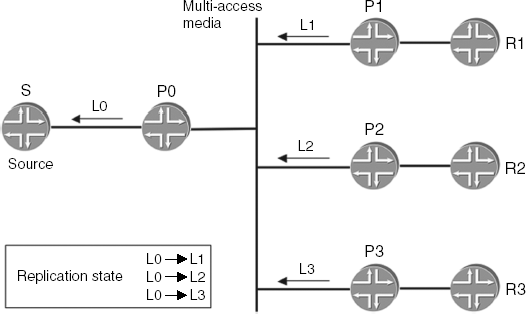6.4. LAN PROCEDURES FOR P2MP LSPS
One of the main goals of P2MP LSPs is to minimize the bandwidth used to distribute the content from the source to all the receivers. Thus, one of the fundamental requirements is to send every packet at most once over any given link. Let us take a look at an interesting problem that arises when dealing with multiaccess links, e.g. Ethernet. Figure 6.5 shows a simple network topology where source S is required to send traffic to three destinations, R1, R2 and R3. The destinations are connected to three transit routers, P1, P2 and P3, which are all on the same LAN.
Figure 6.5. Label allocation on a multiaccess network

To achieve the optimum bandwidth utilization, S sets up a P2MP LSP to the three receivers, according to the procedures described so far. During the setup of the branch LSPs, each of the routers P1, P2 and P3 assigns a label and advertises it to P0. As a result, a single packet is sourced at S towards P0, but three separate copies are sent by P0 towards P1, P2 and P3, although these routers are connected to a shared media and a single packet could have reached all three of them. Indeed, if the three routers had assigned the same label, replication at P0 would not be necessary, and a single packet could be sent over the LAN.
Unfortunately, there can be no guarantee that P1, P2 and P3 assign the same label because they each assign the ...
Get MPLS-Enabled Applications: Emerging Developments and New Technologies now with the O’Reilly learning platform.
O’Reilly members experience books, live events, courses curated by job role, and more from O’Reilly and nearly 200 top publishers.

